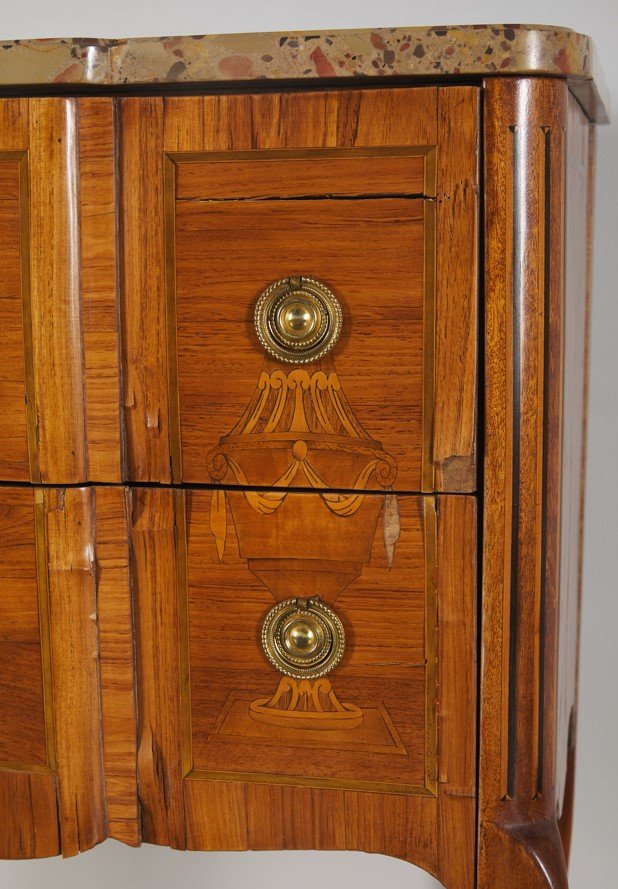When this stunning French commode arrived at The Conservation Center for treatment, our conservators sprang into action to craft a solution that would require both their technical skill and historical knowledge of the art of marquetry.
The commode prior to treatment.
Watch the video below to see our Senior Conservator of Furniture, Rob Kleeman, in action as he glues veneer to the commode! Then, scroll down to learn more about the treatment of this piece and the history of marquetry.
Our conservators knew the process to treat this commode would require skill, patience, and their collective years of knowledge. The surface was covered with a fine layer of particulate matter with scattered accretions. The face of the top drawer was warped and had an open and distorted shrinkage split through the proper left side. The veneer was loose and tented due to shrinkage, and there were areas of loss to the veneer on the top drawer. The bottom drawer face was also warped, with similar veneer insecurities and losses. The front proper right tenon joint was open at the leg-bottom rail. The proper left front leg was warped, and the central tenon between the drawers was open and loose.
The commode prior to treatment.
Detail of the damage to the commode.
Additional detail of the damage to the commode.
Our team quickly got to work: the piece was photographed for in-house documentation before and after treatment. The surface was cleaned overall to remove all oils, waxes, and contaminants. The shrinkage split in the top drawer was stabilized. All loose veneer was stabilized. The retained sections of veneer were reintegrated, and losses were patched as deemed appropriate by the conservator at the time of treatment. The open joinery was disassembled as needed. All joinery was cleaned, refitted, and re-adhered. The warp and distortion of components were minimized as best as possible. The repairs and replacements were retouched and finished to blend with the original surrounding surfaces. The piece was polished, and a protective coat of wax was applied to the finished surfaces. Finally, the stone top was cleaned and waxed.
Now restored to its former glory, this marble-topped French commode was ready to be returned it it’s owners to be admired for years to come.
The commode after treatment.
Slide to see the difference:
A Brief History of Marquetry:
Marquetry is an intricate and stunning art form that involves cutting extremely thin pieces of wood, often in delicate shapes, and arranging them meticulously to form images and patterns. While marquetry has been practiced for thousands of years, it still captivates people today with its ability to transform wood into vibrant, detailed designs. The process demands precision, years of training, and an eye for detail, as each piece is carefully cut, shaped, and assembled like a complex puzzle.
The true artistry of marquetry lies in the way these tiny, carefully chosen pieces fit together to create something much greater than the sum of its parts. Whether it’s floral motifs, geometric patterns, or elaborate scenes, the skill in each design is clear. The wood itself, often complemented by other materials like ivory, bone, or metal, is transformed into an intricate visual story, adding depth and texture to furniture, walls, or decorative objects.
Marquetry is an ancient art form with a rich history that spans thousands of years, evolving across different cultures and time periods. The earliest known examples of marquetry date back to ancient Egypt, where it was used in the decoration of tombs and furniture. The Egyptians were known for their use of inlaid materials, including ivory and wood, to create patterns and designs that reflected both their artistic skill and their reverence for the afterlife. These early examples laid the foundation for what would become a highly refined craft in later centuries.
The technique gained further prominence in the ancient Greek and Roman worlds, though it was somewhat overshadowed by the grandeur of architecture and sculpture. By the time of the Renaissance in Europe, however, marquetry came into its own as a distinctive art form, particularly in Italy, France, and the Netherlands. During this period, furniture became more decorative, and marquetry was often used to adorn cabinets, chests, and tables with intricate scenes, floral motifs, and geometric patterns. The Italians, particularly, were known for their skill in creating finely detailed marquetry, often using contrasting woods to highlight depth and texture.
The 17th and 18th centuries marked the height of marquetry in Europe, especially in France, where it was further developed by skilled artisans at the French court. During the reign of Louis XIV, marquetry was used extensively in the decoration of furniture and interiors, most famously by cabinetmakers like André-Charles Boulle. Boulle is credited with developing the technique that bears his name, "Boulle marquetry," which involved inlaying tortoiseshell, brass, and other materials alongside wood to create striking, intricate patterns. This period is often considered the golden age of marquetry, with the craft reaching its pinnacle in terms of both technique and artistry.
In the 19th century, marquetry saw a decline in popularity with the advent of mass production and industrialization. However, the craft experienced a revival in the 20th century, particularly among collectors and restoration specialists. Today, marquetry continues to be a revered craft, practiced by artisans who appreciate its history and the skill required to produce such beautiful, detailed work. Though modern technology has made it easier to create marquetry using machines, many craftsmen still use traditional hand-cutting methods to maintain the authenticity and artistry of this timeless craft.
Throughout its history, marquetry has remained a symbol of elegance and craftsmanship, showcasing the artistry and dedication of those who continue to practice and preserve this age-old tradition.
To read further about marquetry, click here to read about the treatment of an inlay occasional table, or here to read about the conservation of a 19th century gateleg table.










